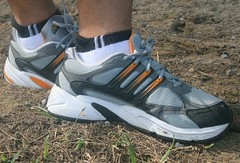In 'O' Biology practical examination, you are required to know Iodine test, Benedict test, Biuret test, Alcohol test and Sulphur test. All or some of these tests are usually used for testing for the presence of food type in a given food sample or specimen and also for testing for the presence of certain materials in a given urine sample. Usually after testing and confirming the presence of these materials in the urine sample, diseases or organ failures can be detected.
A. IODINE TEST (TO DETECT FOR THE PRESENCE OF STARCH)
PROCEDURES
A. IODINE TEST (TO DETECT FOR THE PRESENCE OF STARCH)
PROCEDURES
- Place sample in a test tube.
- Dissolve sample in water.
- Add a few drops (or 3 to 5 cc) of Iodine solution into the test tube.
- Observe.
EXPECTED OBSERVATION AND CONCLUSION
- If brown Iodine solution changed to blue-black (OBSERVATION), starch is present (CONCLUSION).
- If brown Iodine solution remains unchanged (OBSERVATION), starch is absent (CONCLUSION).
B. BENEDICT TEST (TO DETECT FOR THE PRESENCE OF REDUCING SUGAR)
PROCEDURES
- Place the food sample or urine sample in a test tube.
- Add a few drops (or 3 to 5 cc) of Benedict solution into the food sample or urine sample.
- Place the test tube in a water bath for not more than five minutes.
- Observe.
EXPECTED OBSERVATION AND CONCLUSION
- If the blue Benedict solution changed to brick-red (or brown/yellow/orange) (OBSERVATION), reducing sugar is present (CONCLUSION).
- If the blue Benedict solution remains unchanged (OBSERVATION), reducing sugar is absent (CONCLUSION).
- Note: For urine test, the presence of reducing sugar in the urine sample indicates that the person is a Diabetic patient.
C. BIURET TEST (TO DETECT FOR THE PRESENCE OF PROTEIN)
PROCEDURES
- Place the food sample or urine sample in a test tube.
- Add a few drops (or 3 to 5 cc) of Biuret reagent in the test tube containing the food sample or urine sample.
- Observe.
EXPECTED OBSERVATION AND CONCLUSION
- If the blue Biuret reagent changed to purple/violet (OBSERVATION), protein is present (CONCLUSION).
- If the blue Biuret reagent remains unchanged (OBSERVATION), protein is absent (CONCLUSION).
- Note: For urine test, the presence of protein in the urine sample indicates that the person suffers from kidney failure.
D. ALCOHOL TEST (TO DETECT FOR THE PRESENCE OF FATS OR OIL)
PROCEDURES
- Place the dissolved food sample in a test tube.
- Add equal amount of alcohol into the food sample.
- Shake the content of the test tube and leave it to stand or leave it aside for a few minutes.
- Prepare another test tube containing water.
- Pour in the upper layer of the content in the first test tube into the test tube containing water.
- Observe.
EXPECTED OBSERVATION AND CONCLUSION
- If a white emulsion is formed (OBSERVATION), fats or oil is present (CONCLUSION).
- If no white emulsion is formed (OBSERVATION), fats or oil is absent (CONCLUSION).
E. SULPHUR TEST (TO DETECT FOR THE PRESENCE OF BILE)
PROCEDURES
- Place the urine sample to be tested in a test tube.
- Place a spatula-full of sulphur into the test tube containing the urine sample.
- Observe (DO NOT SHAKE).
EXPECTED OBSERVATION AND CONCLUSION
- If sulphur sinks (OBSERVATION), bile is present (CONCLUSION).
- If sulphur floats (OBSERVATION), bile is absent (CONCLUSION).
- Note: The presence of bile in the urine sample further indicates that the person suffers from liver damage.
NOTES:
- If sample or specimen given is in solid form, chop and crush the sample or specimen finely (This is to increase the surface area so that reaction, if any can take place faster)
- Amount of sample to be tested and the amount of test reagents to be used must be stated clearly.
- State the colour clearly in your observation and make sure to state the name of the reagent when describing you observation (Always ask your self: What is it that change colour? Remember, the one having colour is usually the reagent so it is only right that you mention the name of the reagent in your observation)
- For the Benedict test, make sure that your water in the water bath is already boiling before carrying out the test and make sure that you only place the test tube containing the sample or specimen for not more than five minutes (Remember!!! if the sample or specimen happened to contain starch and you are boiling your sample or specimen for more than five minutes, the starch may be hydrolysed or broken down into reducing sugar. This may give you the result that you should not get)
- Iodine test is very simple. If you are given sample in powder or solid form, you simply can place the sample on a white tile without dissolving it in water and then place a few drops of Iodine solution on to it.
- Benedict test is usually time consuming since it requires you to boil the sample or specimen in a water bath. So, manage you time wisely. While waiting, you can always proceed to other tests.
- Iodine test is usually used for detecting starch in food sample.
- Benedict test is usually used for detecting reducing sugar in food sample and urine sample.
- Biuret test is usually used for detecting protein in food sample and urine sample.
- Alcohol test is usually used for detecting fats or oil in food sample.
- Sulphur test is usually used for detecting for the presence of bile in urine sample.
